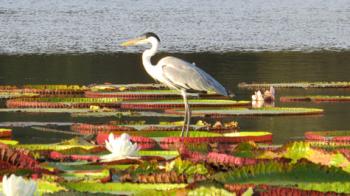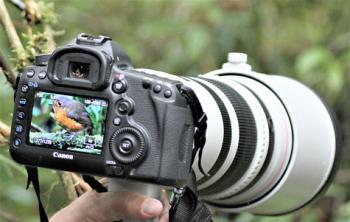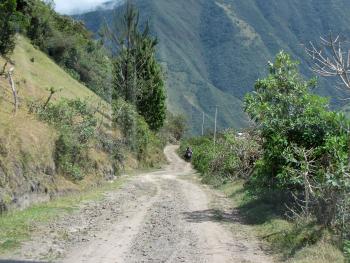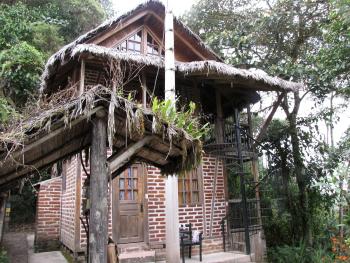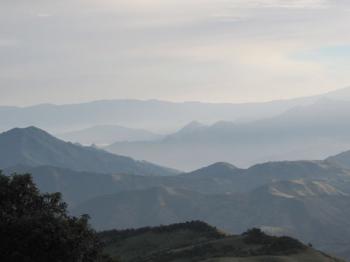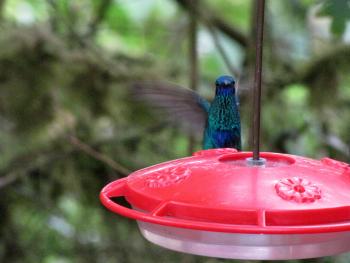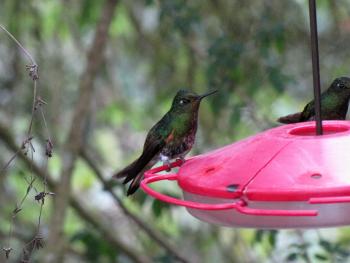A good bird-watching site
Subscribers were invited to write in about places, outside of the US, where they’ve had rewarding sightings of birds. (We cannot accept more submissions.)
In addition to their providing details about the types of birds they saw, we asked travelers to each tell us where they were (including any contact info) and the year, time of year and even time of day of each sighting. We also wanted to know how difficult it was to reach an area, what equipment would be recommended and what the weather was like.
We printed a few letters last month and are continuing with locations in Latin America.
We took a private, customized tour to Venezuela, Guyana, Suriname, French Guiana and Trinidad & Tobago in March 2014 arranged by Jim Turner at Amazing Peru (Av. Petit Thouare 5356, Miraflores, Peru; phone, in the US, 800/704-2915, www.amazingperu.com).
Besides great birding at Canaima National Park (home to Angel Falls) in Venezuela and at Kaieteur National Park (home to Kaieteur Falls) in Guyana, one of the highlights of our adventure was spending two days at the Karanambu Lodge (www.karanambutrustandlodge.org), northeast of Lethem, GUYANA.
Karanambu Lodge has accommodations for 12 people in six thatch-roofed cabins. It is rustic but has modern toilets, showers and running water.
Our initial primary purpose of the stay was to view the giant river otter rehabilitation center located there. However, it also turned out to be a birder’s delight.
It was an absolute treat to spend time with Diane McTurk, the owner of the lodge, and hear her stories about the ranch and the unique flora and fauna there. The main lodge building also houses a small library with a great variety of bird books — a necessity when not with a naturalist or guide.
Located on the Rupununi River, the lodge provided us with two naturalist guides for our stay. Together, the four of us went by foot or small boat to explore both the tropical savannah and the river. Besides seeingwildlife such as anteaters, caimans, squirrel monkeys and iguanas, we viewed an abundance of birds we had not seen before.
Some of the highlights, for us, were species such as the rare green-and-rufous kingfisher, green kingfisher, cocoi heron, pied water tyrant and the spectacular capuchinbird, which we heard well before we saw it. Its loud call sounded like a cross between a cow mooing and a chainsaw!
We visited lily ponds where Victoria amazonica, the world’s largest water lily and Guyana’s national flower, abounded. The lilies are frequented by many species of birds, including the crestless curassow and the jacana. We also saw caimans hoping for a jacana dinner.
Sharp-tailed ibises, ospreys, crimson-mantled woodpeckers, jabiru storks and orange-winged Amazon parrots round out examples from this remarkable natural area. And the giant river otters were pretty neat, too.
The weather on the Guyana savannah in mid-March was very pleasant. An almost constant breeze kept it from being too hot, and the early mornings were comfortably cool. We took walks and canoe rides in both the early morning and early evening, and with sufficient insect repellent we could enjoy all of our time out looking for birds and animals.
Equipment “musts” include a good pair of binoculars, a camera, bush clothing, shoes and insect repellent.
Any traveler with a well-developed sense of adventure will be rewarded with an incredible experience on this journey to a birding paradise.
Denzil & Jennie Verardo
Elk Grove, CA
I was part of a group of eight on a 9-day visit to COLOMBIA in December 2014 with International Expeditions (Helena, AL; 855/548-5929, ietravel.com).
At Laguna Negra (elevation, 13,360 feet), just north of Los Nevados National Natural Park, lakeside reeds provided great photo opportunities of grass wrens (Cistothorus platensis). With a range from Mexico to Tierra del Fuego, it is not a rare bird. Feeding on insects and spiders, the wrens constantly moved through the reeds.
A few other birds spotted in the Laguna Negra area were the rufous-fronted parakeet, black-chested buzzard-eagle and brown-backed chat-tyrant.
We arrived at Hotel Termales del Ruiz (Paraje de Termales, Villamaría, Caldas, Colombia; phone +57 310 455 3588, hoteltermales delruiz.com), just outside Los Nevados Park, in time for a great steak lunch.
The hotel is known as a place to spot higher-elevation hummingbirds, and among the many species we sighted were golden-breasted puffleg, viridian metaltail and rainbow-bearded thornbill.
Departing the next morning at 6, we traveled to Rio Blanco Nature Reserve, which encompasses 12,187 acres in the cloud forest at an elevation of 4,000 to 7,000 feet.
Within a few hours, we had observed three of the five species of antpitta that are endemic there: the brown-banded, bicolored and slate-crowned. Primarily ground feeders, antpittas are extremely camera-shy.
That day ended with a total of 63 species, with tanagers and hummingbirds dominating the count. For the entire birding trip, our group spotted a total of 322 species.
Fred Koehler
Orange, CA
Before flying to the Galápagos Islands to meet our cruise ship in August 2009, my wife, Lisa, and I and some friends had a full day in Quito, ECUADOR. While they took a city tour provided by the cruise line, I took a private, guided birding trip.
I had arranged it for $260 through an ecoresort, the Bellavista Cloud Forest Reserve (Tandayapa, Ecuador; phone +593 2 223 2313, www.bellavistacloudforest.com), which is located deep in the Andean cloud forest though fewer than 20 miles northwest of Quito as the crow flies (if there were crows in Ecuador).
They offered several tours. I specifically wanted a birding tour, so they contracted with Robert Jonsson, who owns the company Avestravel (www.avestravel.com). Robert is from Sweden and has led birding tours all over South America.
A little after 5:30 a.m., Robert picked me up in the lobby of my hotel and we drove northwest out of Quito. We soon left paved roads for dirt and gravel. Central Quito is 9,350 feet above sea level, but our first stop, Yanacocha Reserve, was even higher, at about 11,600 feet.
Before even reaching the entrance to the reserve, we flushed several giant thrushes and a few rufous-collared sparrows (the only bird I would see that day that I’d seen before, in Ushuaia).
While we ate a meal at a small parking area on the side of the road, I was entertained by several hummingbirds coming to the feeders near the picnic tables, including a shining sunbeam (actually pretty dull-lookingexcept for a spot on its back) and a female mountain velvetbreast.
Yanacocha Reserve had a single wide path that ran alongside the water-supply complex and then narrowed to a footpath that followed the side of a mountain for a mile or so and was nearly level the whole way.
The pace was easy, and we didn’t take any of the narrower and steeper side paths. (I’ve never suffered from altitude sickness, fortunately, but I still wasn’t in any shape to deal with steep inclines after being at that altitude for less than 12 hours.)
We stopped frequently for new bird species, including several that we only heard but which Robert was able to identify by their calls.
One of the coolest hummingbirds we saw was the sword-billed. Head to tail, the total length of the bird is 5 to 5¼ inches, but it has an additional 3½ to 4 inches of bill. My field guide listed it as “Scarce and local.”
At the end of the path, a panoramic view of the Andes opened up around us. There we saw a great sapphirewing hummingbird, at 6 inches one of the largest hummingbirds in the world.
On the trip from Yanacocha to our next stop, Bellavista Cloud Forest Reserve, we dropped in altitude to below 1,000 meters (3,280 feet). For a while we followed a rushing mountain stream, Rio Alambi.
When we reached a small bridge over the river, I walked off the road onto what I thought was a grassy patch and stepped right into a very small but cold rill. It was completely covered by vegetation, so I didn’t see it. I got both feet wet and muddy. Before I could deal with that, Robert spotted a white-capped dipper; I was able to get off a few shots with my camera.
I took off my wet socks, dried out the inside of my shoes as best I could and put them on bare feet. I was fine for the rest of the day (but the jeans would have to be laundered).
In that spot, we also heard a slaty-backed chat-tyrant, one of the many species of flycatchers in Ecuador. Robert tried to lure it into view by playing a recording of its call on an MP3 player, but he was unsuccessful.
Among other species Robert pointed out to me in the reserve were the red-faced spinetail, yellow-rumped tanager and slate-throated whitestart.
When we got to the Bellavista lodge, we spent a while watching the hummingbirds coming to the feeders. I’ve never seen so many different ones at once. Feeders all around the lodge were crowded with hummingbirds. I could have spent hours just sitting on a bench and watching them all come in.
A rustic resort perched on the side of a densely vegetated mountainside, Bellavista is an ecolodge. When we arrived, it was shrouded in clouds (as it should be, as it’s in a cloud forest), but later on, the sky cleared a bit. The vegetation was so dense that not a lot of light was available for photos.
We walked a short way down one of the many trails there and saw a mixed flock of tanagers, including grass-green, blue-winged mountain, blue-and-black and golden. We also saw one of the highlights of my tour: a plate-billed mountain toucan.
Around 3 o’clock, it was time to start back for Quito. I was reluctant to leave all those lovely hummingbirds, but we had a 2-hour drive.
It had been a great birding day, with sightings of 66 species (including 18 species of hummingbirds).
For equipment, I had a Canon SX10 IS digital camera (which I have long since upgraded to a Canon HS50 IS) and Leupold 10x50 binoculars.
Andrew Cubbon
Marietta, GA

